北师大版高中英语必修2U6 Design--L1 A Matter of Taste(ppt)(广东省佛山市顺德区)
文档属性
| 名称 | 北师大版高中英语必修2U6 Design--L1 A Matter of Taste(ppt)(广东省佛山市顺德区) | 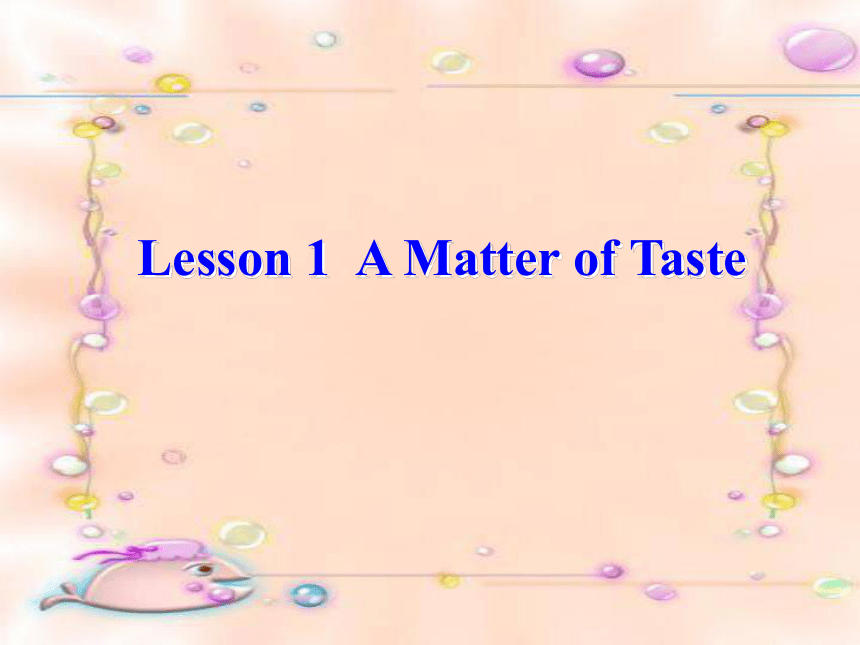 | |
| 格式 | rar | ||
| 文件大小 | 545.9KB | ||
| 资源类型 | 教案 | ||
| 版本资源 | 北师大版 | ||
| 科目 | 英语 | ||
| 更新时间 | 2007-12-20 12:41:00 | ||
图片预览

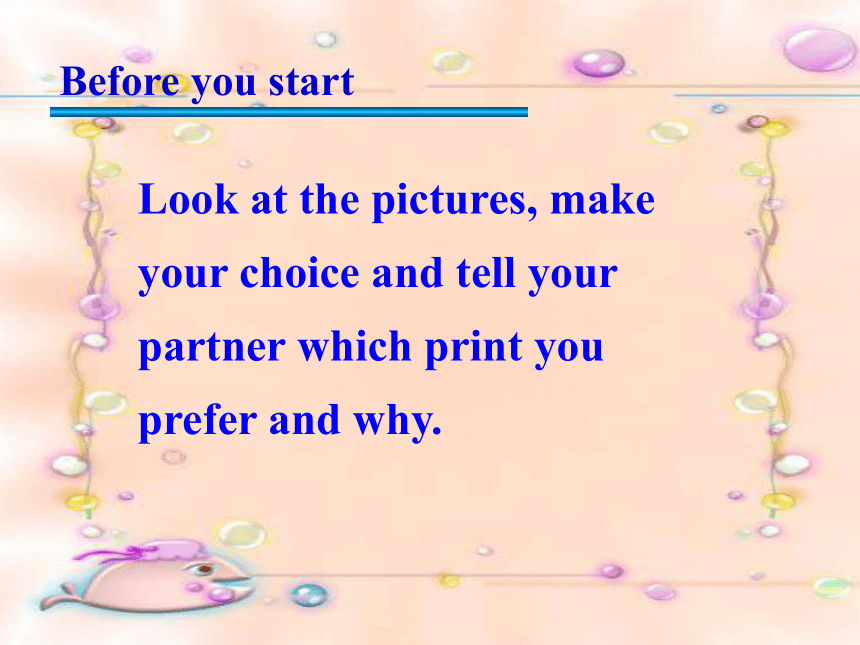
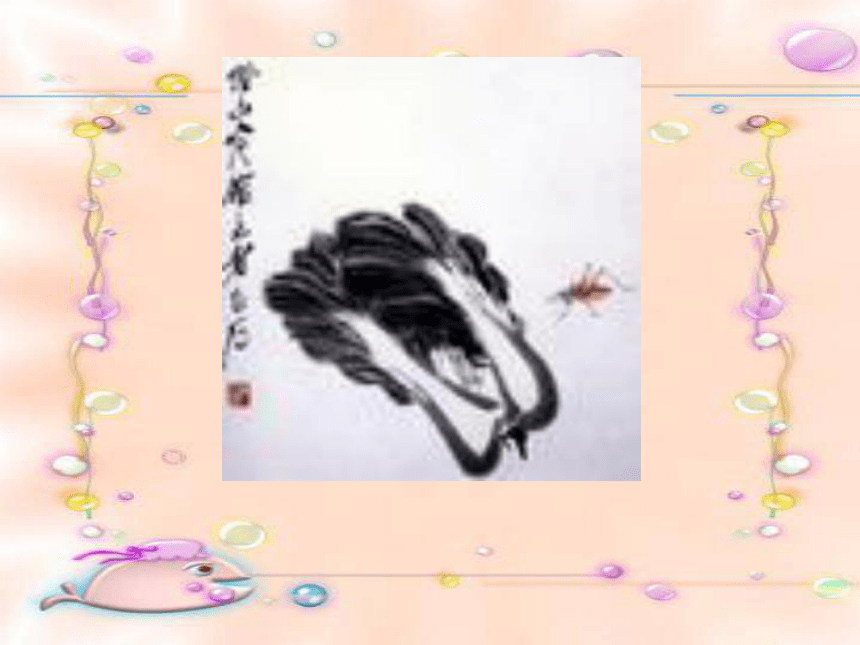
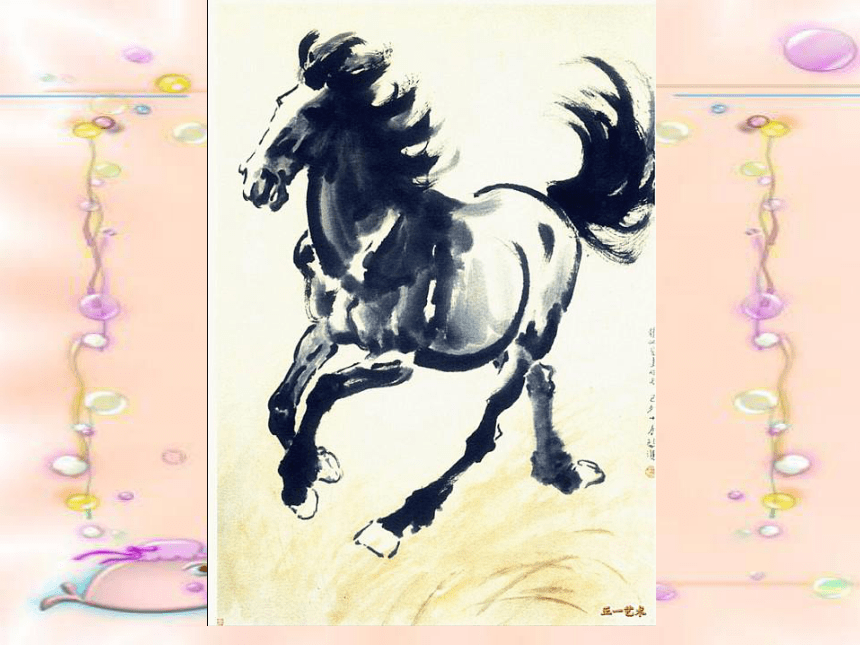
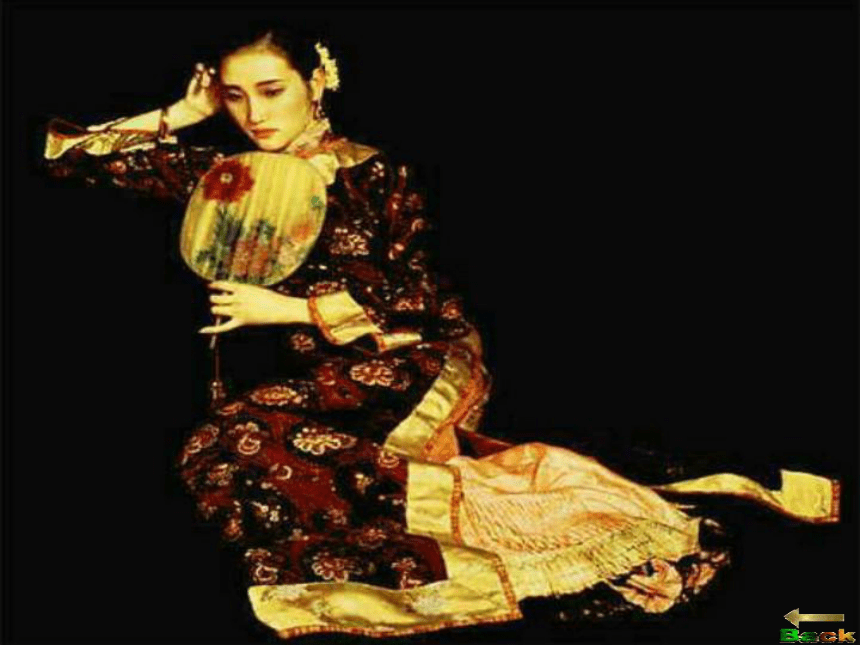
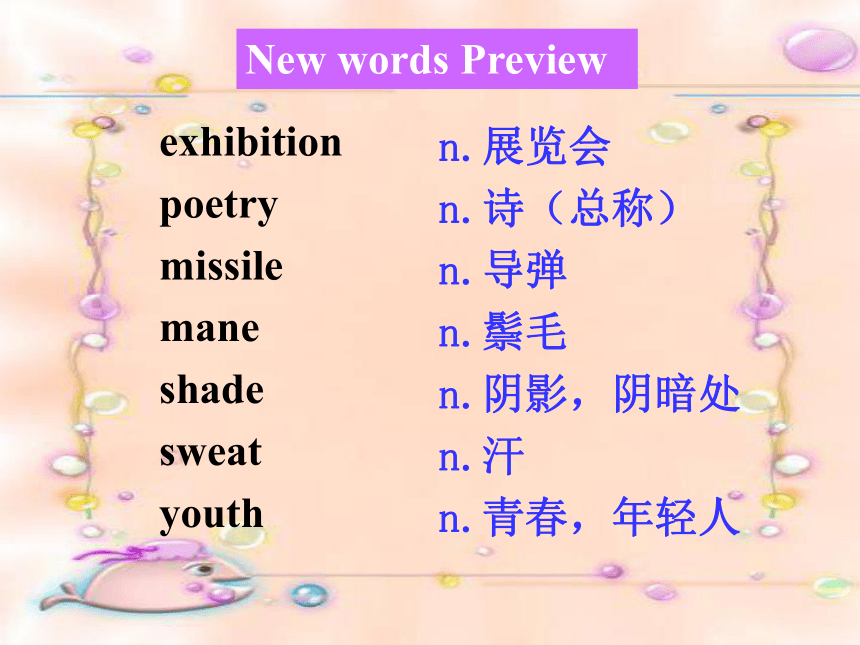
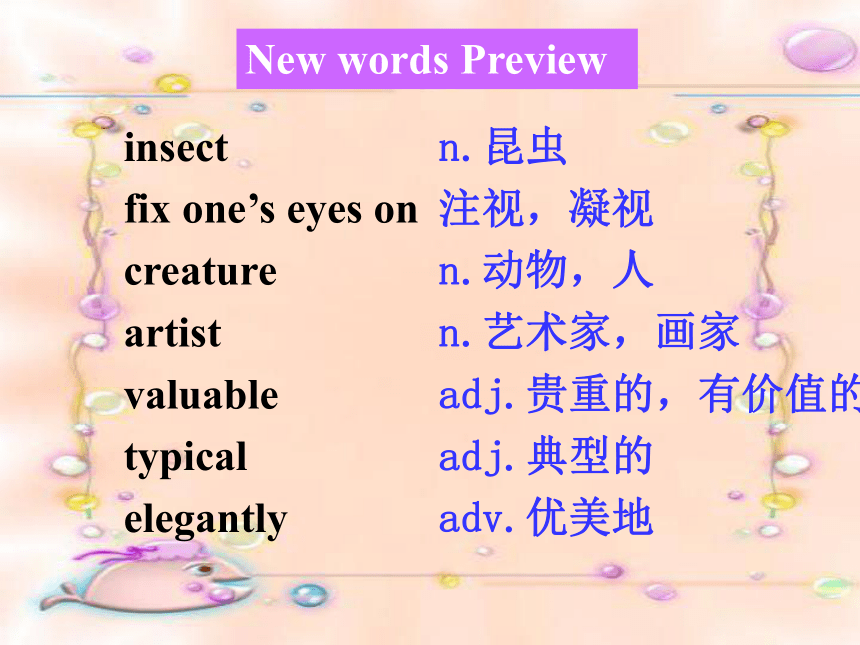
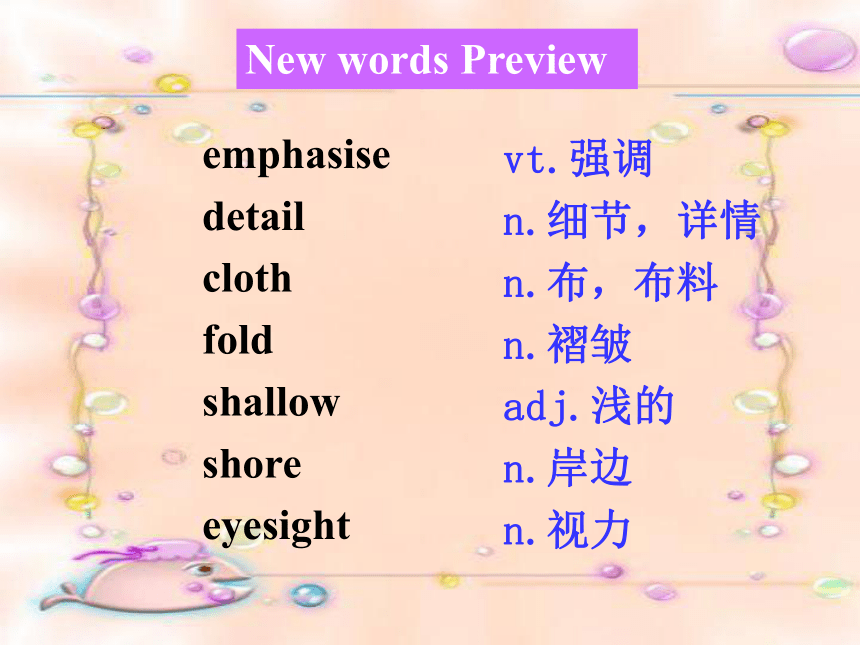
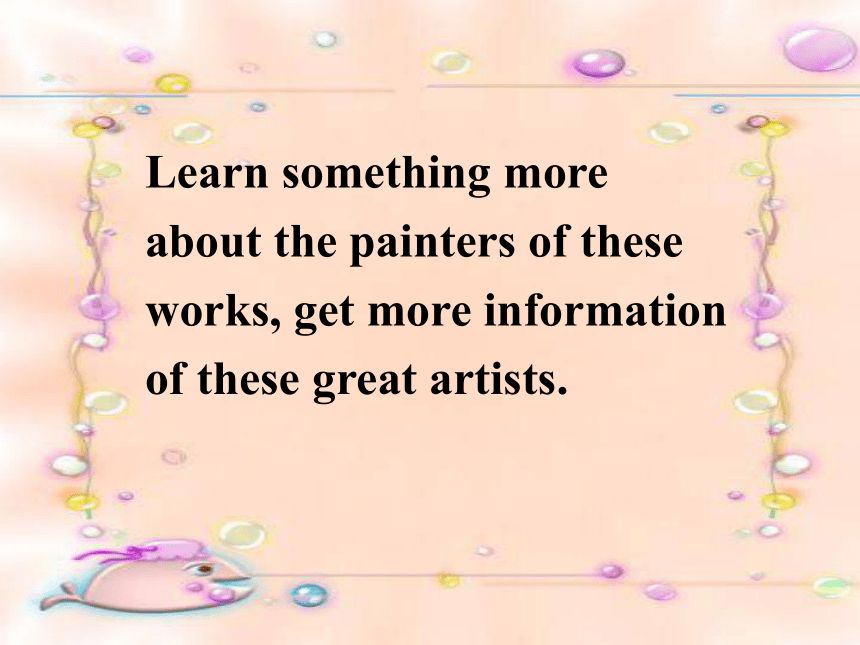
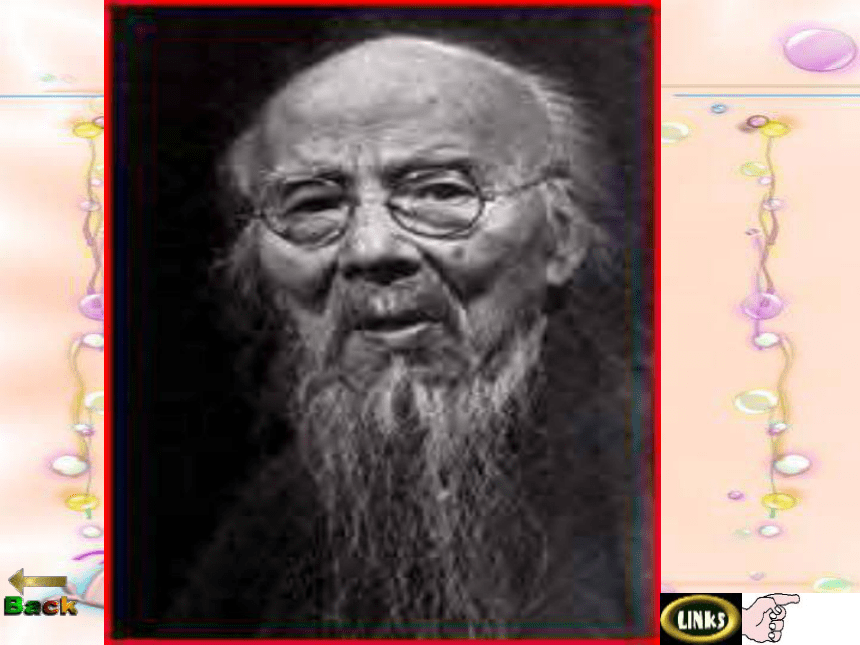
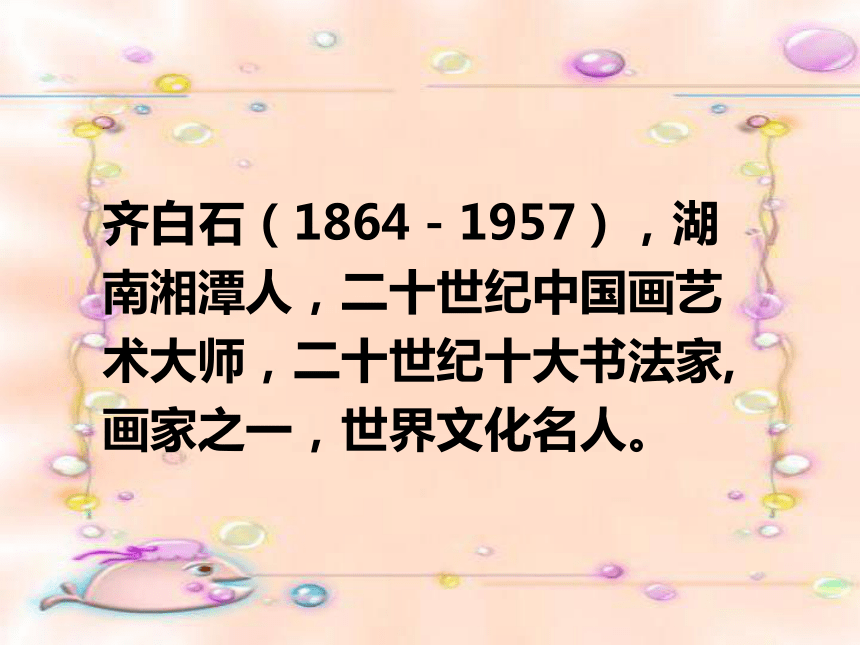
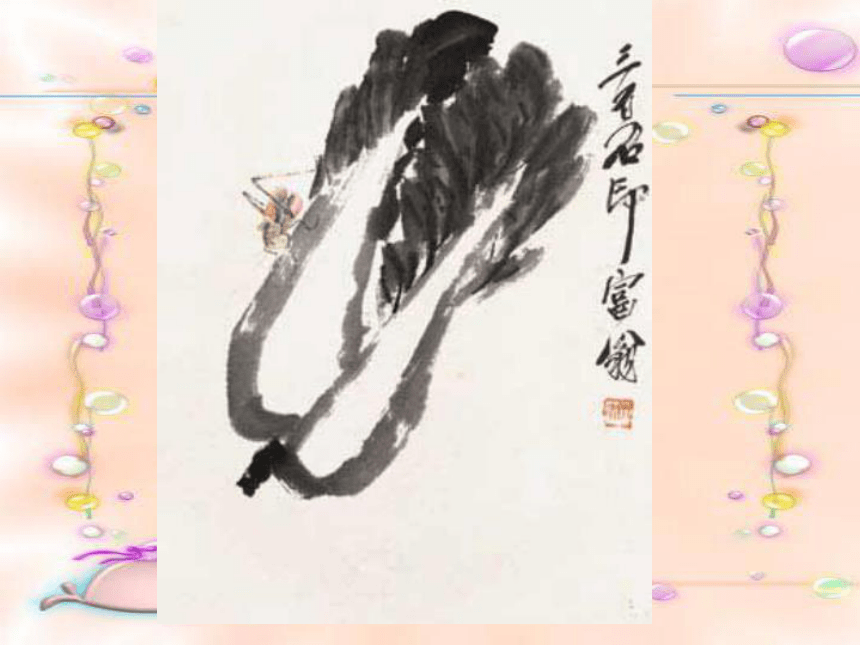
文档简介
课件64张PPT。Lesson 1 A Matter of TasteLook at the pictures, make your choice and tell your partner which print you prefer and why. Before you startNew words Previewexhibition
poetry
missile
mane
shade
sweat
youthn.展览会
n.诗(总称)
n.导弹
n.鬃毛
n.阴影,阴暗处
n.汗
n.青春,年轻人insect
fix one’s eyes on
creature
artist
valuable
typical
elegantlyNew words Previewn.昆虫
注视,凝视
n.动物,人
n.艺术家,画家
adj.贵重的,有价值的
adj.典型的
adv.优美地emphasise
detail
cloth
fold
shallow
shore
eyesightNew words Previewvt.强调
n.细节,详情
n.布,布料
n.褶皱
adj.浅的
n.岸边
n.视力Learn something more about the painters of these works, get more information of these great artists.
齐白石(1864-1957),湖南湘潭人,二十世纪中国画艺术大师,二十世纪十大书法家,画家之一,世界文化名人。
徐悲鸿(1895-1953),是兼采中西艺术之长的现代绘画大师,前驱式的美术教育家。 陈逸飞(1946-2005)生于宁波,浙江镇海人。 1984年,美国《艺术新闻》杂志将陈逸飞定名为“一个浪漫的写实主义者,作品流露强烈的怀旧气息,弥漫其中的沉静与静寂氛围尤其动人。” Read the text Chinese Prints and complete the table.Newman Gallery, Dinham 1 July to 15 September Xu Beihong, Qi Baishi and Chen Yifei Racing Horse, Cabbage and Poppy a horse running at high speed; a tiny insect fixing its eyes on the cabbage nearby; a young woman sitting alone, deep in thought, her hand holding the fan above her knees black, grey, dark, light ReadingExhibition: Chinese PrintsRacing HorseCabbagePoppyRead the text, pleaseThen answer the questions.Task 1Who is famous for drawing pretty women?2.Who is more good at drawing simple pictures we often see in our life.3. Why did Chen Yifei use black as the background of Poppy.4.Who held exhibitions abroad to advance Chinese art?5. What is Xu Beihong’s masterpiece?Who is famous for drawing pretty women?Chen Yifei.
He is famous for his soft portraits of beautiful women.Qi Baishi
He draw simple pictures from everyday life, such as vegetable, flowers, birds and insects.2.Who is more good at drawing simple pictures we often see in our life.4.Who held exhibitions abroad to advance Chinese art?Xu Beihong.3. Why did Chen Yifei use black as the background of Poppy.To emphasize the woman even more.Racing horse5. What is Xu Beihong’s master
piece?correct errorsChen Yifei’s works is very valuable, and one of his paintings sold at US$ 503,000.
2.The end of the novel leaves readers guess and imagination.forguessing3.Her hand hold the fan is elegantly positioned above her knees.holding4. He traveled cross the country and painted many pictures.across5.It’s back eyes, that are fixed on the cabbage, show the creature’s interest in the cabbage. whicha∧6.The painting of dark and light color is favorite of many art lovers.Read the text ,work in group(4人) and find:
1.General idea of each paragraph(段落大意)
2.the Prepositions of time, place and movement(时间,地点,方位介词)
3.Phrases (词组搭配)
NON-FINITE VERBS非谓语动词,Relative Clause定语从句Para. 1: the introduction of Xu Beihong and his painting named Racing horce
Para. 2: the introduction of Qi Baishi and his painting named Cabbage.
Para. 3:Language pointsbe fixed on 用(眼睛等) 盯住,凝视;吸引(注意)他盯着这条蠕动的蛇, 充满了恐惧。 He was fixed on the moving snake , full of fear.汤姆的注意力都集中在他正在画的图上。 Tom fixed his attention on the
picture that he was drawing.2. leave
表示“使/让(某人/某物)处于某状态。后面接现在分词, 形容词, 过去分词做宾语补足语。别让她在外边雨中等着。Don’t leave her waiting outside in the rain.让门开着吧。小汤姆跑了出去, 留下了没写完的作业。Leave the door open, please.Little Tom ran out of the door, leaving the homework undone.3. be deep /lost in thought陷入沉思增添, 添加迪克盯着窗外,陷入了沉思。Dick was staring out of the window, lost in thought.4. add …to 你想把自己的名字加到名单里吗? add
Do you want to add your name to the list?add up to合计,总共His whole school education added up to no more than one year.他的整个学校教育加起来总共不到一年。5. show /take interest in
David show interest in biology and want to do research in it in the future.对…表现出兴趣大卫对生物感兴趣,将来想从事这方面的研究。Answers for reference3(1) artist; (2) gallery; (3) painter; (4) exhibition; (5) paintings; (6) details (7) elegant; (8) shades; (9) emphasiseGrammarPrepositions of time, place, and movementA preposition describes a relationship between other words in a sentence. 介词是一种用来表示词与词, 词与句之间的关系的词。在句中不能单独作句子成分。介词后面一般有名词、代词或相当于名词的其他词类,短语或从句作它的宾语。介词和它的宾语构成介词词组,在句中作主语, 状语,表语,补语或介词宾语。 表示时间的介词,at, on, in, during, for, to, till, until, after, by, before等。1. at, on, in
at用来表示时间时,通常指时间的某一点。如:at five o’clock, at noon, at midnight
on用来表示某一段时间,特指某天或某天的上午, 下午或晚上。如:on Sunday, on October, on Saturday morning.
in也可用来表示一段时间,但多指长于一天或不到一天的时间段。如:in January, in summer, in 1988, in the morning, in the evening. 2. in与during
during用来表示一段时间,其意义大致相当于in的用法。一般来说,凡是能用in的地方,也可以用during.如:He came to see me during my absence. Don’t go to see his wife in his absence.
during与in的区别在于during强调时间的延续性,而in则只是一般指某一时间。试比较:They visited many cities during their stay in China. Her grandpa was killed in the war.3. in, for, during
“in+时间”与“for+时间”都可表示一段时间,但“for+时间”表示“有多久”,而“in+时间”则表示“在何时”。如:We worked there for the winter. They worked there in winter.
以上两例中,in winter强调“在冬季”,不一定包括整个冬季时间,而for the winter则强调“整个冬天”。
for用来表示一般时间,常跟具体的时间段。如 for a few days for 3 weeks for five months等4. since与after都可以用来引导表示从过去某一点开始的时间段词组。它们的不同之处在于:
since引导的词组所表示的时间一直延续到说话时为止,因而要与现在完成时连用。如:He has been there twice since 1982.I have done nothing since six o’clock.
after引导的词组所表示的时间是纯系过去,并不延续到说话时,因此要和一般过去时连用。如:He went home after school.5. till, until与to
介词till/until常用于“from.……till/until”结构中,表示“一个动作的终结”。介词to常用在“from.……to”的结构中,用来表示“一个阶段的终结”。两者在这种结构中意义十分接近。如:The Americans stayed here from June to September. He studies from morning till/until night everyday. to可用在表示钟点的词前。我们说It’s six to five 但不能说It’s six till/until five.反之在某些能用till/until的场合,却不能用to. 如:在“not.……until”结构中,我们说I didn’t go to bed till/until ten o’clock.却不能说I didn’t go to bed to ten o’clock.
till与until也有细微区别。till常用在非正式文体或口语中,而until则常用于正式文体及比较正式的场合。另外,在句首多用until.6. by, before
by表示时间时,意思是“到……以前”、“不迟于”、“到……时(为止)”。例如:by supper time, by the end of last term
before表示时间,意为“在……以前”。例如:before liberation, the day before yesterdayc)by与before的区别在于,by短语表示时间,强调“终止点”,而before短语表示时间,强调“起始点”。如:Your son will be all right by suppertime.
句中的by suppertime表示从说话时到晚饭前这段时间。而before构成短语则表示从某一时间或事件之前,如:The poor children couldn’t go to school before liberation.表示地点的介词above the lake/ below the clouds, at home, at the bank, at the seaside, behind the tree, between the bank and the park, in Baker Street, in the box, in the picture, on the table, on the bus, on the first floor, under the bridge/ over the table表示动作的介词across the park, along the river, into the building, to/from WarsawAnswers for referenceduring
betweenbehind
near
between
above across
along 461. in; 2. with; 3. by; 4. Across; 5. through; 6. for; 7. on; 8. in; 9. As; 10. at Practice for vocabulary Complete the sentences with the words below. add, audience, combine, creative, critic, emphasise, fix, imagination, promote, tradition1. He designed the first great suspension bridge, an idea that _________ beauty and fun_ction perfectly.
2. John _______ some water to the paint to make it thinner. combines added 3. She ________ her eyes on the jagged line of rocks to which she had to climb. 4. You don’t have to use your ___________ when you’re watching television. fixed imagination 5. A balanced diet ________ good health and normal development. 6. The show has delighted television _______ in the United States and Britain. promotes audience 7. The Prime Minister _________ that there are no plans to raise taxes. 8. We always go for a long walk on Christmas morning ? It’s a family _________. emphasised tradition 9. I didn’t think the book was as bad as the _________ said it was. 10. I enjoy my job, but I’d like to do something more ________. critics creative HomeworkDesign a picture or a photo with the words we have learned today
poetry
missile
mane
shade
sweat
youthn.展览会
n.诗(总称)
n.导弹
n.鬃毛
n.阴影,阴暗处
n.汗
n.青春,年轻人insect
fix one’s eyes on
creature
artist
valuable
typical
elegantlyNew words Previewn.昆虫
注视,凝视
n.动物,人
n.艺术家,画家
adj.贵重的,有价值的
adj.典型的
adv.优美地emphasise
detail
cloth
fold
shallow
shore
eyesightNew words Previewvt.强调
n.细节,详情
n.布,布料
n.褶皱
adj.浅的
n.岸边
n.视力Learn something more about the painters of these works, get more information of these great artists.
齐白石(1864-1957),湖南湘潭人,二十世纪中国画艺术大师,二十世纪十大书法家,画家之一,世界文化名人。
徐悲鸿(1895-1953),是兼采中西艺术之长的现代绘画大师,前驱式的美术教育家。 陈逸飞(1946-2005)生于宁波,浙江镇海人。 1984年,美国《艺术新闻》杂志将陈逸飞定名为“一个浪漫的写实主义者,作品流露强烈的怀旧气息,弥漫其中的沉静与静寂氛围尤其动人。” Read the text Chinese Prints and complete the table.Newman Gallery, Dinham 1 July to 15 September Xu Beihong, Qi Baishi and Chen Yifei Racing Horse, Cabbage and Poppy a horse running at high speed; a tiny insect fixing its eyes on the cabbage nearby; a young woman sitting alone, deep in thought, her hand holding the fan above her knees black, grey, dark, light ReadingExhibition: Chinese PrintsRacing HorseCabbagePoppyRead the text, pleaseThen answer the questions.Task 1Who is famous for drawing pretty women?2.Who is more good at drawing simple pictures we often see in our life.3. Why did Chen Yifei use black as the background of Poppy.4.Who held exhibitions abroad to advance Chinese art?5. What is Xu Beihong’s masterpiece?Who is famous for drawing pretty women?Chen Yifei.
He is famous for his soft portraits of beautiful women.Qi Baishi
He draw simple pictures from everyday life, such as vegetable, flowers, birds and insects.2.Who is more good at drawing simple pictures we often see in our life.4.Who held exhibitions abroad to advance Chinese art?Xu Beihong.3. Why did Chen Yifei use black as the background of Poppy.To emphasize the woman even more.Racing horse5. What is Xu Beihong’s master
piece?correct errorsChen Yifei’s works is very valuable, and one of his paintings sold at US$ 503,000.
2.The end of the novel leaves readers guess and imagination.forguessing3.Her hand hold the fan is elegantly positioned above her knees.holding4. He traveled cross the country and painted many pictures.across5.It’s back eyes, that are fixed on the cabbage, show the creature’s interest in the cabbage. whicha∧6.The painting of dark and light color is favorite of many art lovers.Read the text ,work in group(4人) and find:
1.General idea of each paragraph(段落大意)
2.the Prepositions of time, place and movement(时间,地点,方位介词)
3.Phrases (词组搭配)
NON-FINITE VERBS非谓语动词,Relative Clause定语从句Para. 1: the introduction of Xu Beihong and his painting named Racing horce
Para. 2: the introduction of Qi Baishi and his painting named Cabbage.
Para. 3:Language pointsbe fixed on 用(眼睛等) 盯住,凝视;吸引(注意)他盯着这条蠕动的蛇, 充满了恐惧。 He was fixed on the moving snake , full of fear.汤姆的注意力都集中在他正在画的图上。 Tom fixed his attention on the
picture that he was drawing.2. leave
表示“使/让(某人/某物)处于某状态。后面接现在分词, 形容词, 过去分词做宾语补足语。别让她在外边雨中等着。Don’t leave her waiting outside in the rain.让门开着吧。小汤姆跑了出去, 留下了没写完的作业。Leave the door open, please.Little Tom ran out of the door, leaving the homework undone.3. be deep /lost in thought陷入沉思增添, 添加迪克盯着窗外,陷入了沉思。Dick was staring out of the window, lost in thought.4. add …to 你想把自己的名字加到名单里吗? add
Do you want to add your name to the list?add up to合计,总共His whole school education added up to no more than one year.他的整个学校教育加起来总共不到一年。5. show /take interest in
David show interest in biology and want to do research in it in the future.对…表现出兴趣大卫对生物感兴趣,将来想从事这方面的研究。Answers for reference3(1) artist; (2) gallery; (3) painter; (4) exhibition; (5) paintings; (6) details (7) elegant; (8) shades; (9) emphasiseGrammarPrepositions of time, place, and movementA preposition describes a relationship between other words in a sentence. 介词是一种用来表示词与词, 词与句之间的关系的词。在句中不能单独作句子成分。介词后面一般有名词、代词或相当于名词的其他词类,短语或从句作它的宾语。介词和它的宾语构成介词词组,在句中作主语, 状语,表语,补语或介词宾语。 表示时间的介词,at, on, in, during, for, to, till, until, after, by, before等。1. at, on, in
at用来表示时间时,通常指时间的某一点。如:at five o’clock, at noon, at midnight
on用来表示某一段时间,特指某天或某天的上午, 下午或晚上。如:on Sunday, on October, on Saturday morning.
in也可用来表示一段时间,但多指长于一天或不到一天的时间段。如:in January, in summer, in 1988, in the morning, in the evening. 2. in与during
during用来表示一段时间,其意义大致相当于in的用法。一般来说,凡是能用in的地方,也可以用during.如:He came to see me during my absence. Don’t go to see his wife in his absence.
during与in的区别在于during强调时间的延续性,而in则只是一般指某一时间。试比较:They visited many cities during their stay in China. Her grandpa was killed in the war.3. in, for, during
“in+时间”与“for+时间”都可表示一段时间,但“for+时间”表示“有多久”,而“in+时间”则表示“在何时”。如:We worked there for the winter. They worked there in winter.
以上两例中,in winter强调“在冬季”,不一定包括整个冬季时间,而for the winter则强调“整个冬天”。
for用来表示一般时间,常跟具体的时间段。如 for a few days for 3 weeks for five months等4. since与after都可以用来引导表示从过去某一点开始的时间段词组。它们的不同之处在于:
since引导的词组所表示的时间一直延续到说话时为止,因而要与现在完成时连用。如:He has been there twice since 1982.I have done nothing since six o’clock.
after引导的词组所表示的时间是纯系过去,并不延续到说话时,因此要和一般过去时连用。如:He went home after school.5. till, until与to
介词till/until常用于“from.……till/until”结构中,表示“一个动作的终结”。介词to常用在“from.……to”的结构中,用来表示“一个阶段的终结”。两者在这种结构中意义十分接近。如:The Americans stayed here from June to September. He studies from morning till/until night everyday. to可用在表示钟点的词前。我们说It’s six to five 但不能说It’s six till/until five.反之在某些能用till/until的场合,却不能用to. 如:在“not.……until”结构中,我们说I didn’t go to bed till/until ten o’clock.却不能说I didn’t go to bed to ten o’clock.
till与until也有细微区别。till常用在非正式文体或口语中,而until则常用于正式文体及比较正式的场合。另外,在句首多用until.6. by, before
by表示时间时,意思是“到……以前”、“不迟于”、“到……时(为止)”。例如:by supper time, by the end of last term
before表示时间,意为“在……以前”。例如:before liberation, the day before yesterdayc)by与before的区别在于,by短语表示时间,强调“终止点”,而before短语表示时间,强调“起始点”。如:Your son will be all right by suppertime.
句中的by suppertime表示从说话时到晚饭前这段时间。而before构成短语则表示从某一时间或事件之前,如:The poor children couldn’t go to school before liberation.表示地点的介词above the lake/ below the clouds, at home, at the bank, at the seaside, behind the tree, between the bank and the park, in Baker Street, in the box, in the picture, on the table, on the bus, on the first floor, under the bridge/ over the table表示动作的介词across the park, along the river, into the building, to/from WarsawAnswers for referenceduring
betweenbehind
near
between
above across
along 461. in; 2. with; 3. by; 4. Across; 5. through; 6. for; 7. on; 8. in; 9. As; 10. at Practice for vocabulary Complete the sentences with the words below. add, audience, combine, creative, critic, emphasise, fix, imagination, promote, tradition1. He designed the first great suspension bridge, an idea that _________ beauty and fun_ction perfectly.
2. John _______ some water to the paint to make it thinner. combines added 3. She ________ her eyes on the jagged line of rocks to which she had to climb. 4. You don’t have to use your ___________ when you’re watching television. fixed imagination 5. A balanced diet ________ good health and normal development. 6. The show has delighted television _______ in the United States and Britain. promotes audience 7. The Prime Minister _________ that there are no plans to raise taxes. 8. We always go for a long walk on Christmas morning ? It’s a family _________. emphasised tradition 9. I didn’t think the book was as bad as the _________ said it was. 10. I enjoy my job, but I’d like to do something more ________. critics creative HomeworkDesign a picture or a photo with the words we have learned today
